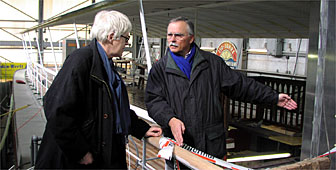
Detective work helps restoration of paddle steamer

The Lötschberg, the last remaining paddle steamer on Lake Brienz, is receiving a long-overdue facelift. The restoration work is being led by an architect with a passion for the historical and for solving mysteries.
Rolf Lemberg climbs onto the lower deck of the Lötschberg, in dry dock at the shipyard in Interlaken, and opens a small metal flap on the outside wall of the engine room. Behind the door is an empty compartment.
“If you’re working with an old boat, you discover things that nobody can explain,” he says. “Nobody knew what the compartment was used for. But if you do some research, and ask around, you can learn some fascinating things.”
He found that when the ship made a stop, children of the crew would often come on board to bring the members a hot meal. They placed the dishes in the empty compartment where they were kept warm by the boiler until the crew had time to eat.
Similar compartments were standard features in many of the paddle steamers built in Switzerland in the early 20th century. A couple dozen paddle steamers from this period have been restored, but many such details, which reveal as much about life on the Swiss lakes during the era as they do about steamboat travel, were welded shut or simply removed.
Lemberg, who divides his time between his native Germany and a second home in the Bernese Oberland, has spent the last 25 years restoring historical buildings. He says he was determined not to let ignorance interfere with the restoration of the Lötschberg.
“If you begin with such a project, you have to find out how things were at the time. In this case, you find puzzling architectural details, which had no apparent purpose.”
After many enquiries, the architectural sleuth discovered that local women were clever enough to take advantage of the extreme heat generated by the boilers. He heard stories of how they used to place racks of ripe plums on the boiler through another door opening onto the engine room. One trip round the lake was enough to turn them into prunes.
For that very reason, the two doors, though serving no practical purpose today, are being retained by Lemberg, as well as a round lid covering a hole in the floor where the crew used to throw sacks of coal down into the engine room.
“Some elderly people still know what these things were used for,” he says, “and they can show their grandchildren.”
Licenced to carry 750 passengers, the Lötschberg was launched on July 25, 1914 to help cope with the increasing numbers of tourists coming to travel through the fjord-like landscape and marvel at the spectacular waterfalls emptying into the lake.
Three days later, Austria-Hungary declared war on Serbia, marking the start of the First World War.
“A few weeks after the boat was launched, it was put back in dry dock because there were no more tourists coming to Switzerland because of the war,” says Gerhard Schmid, president of a private association set up in 1993 to save another paddle steamer, the Blümlisalp, which operates on neighbouring Lake Thun.
The Lötschberg was kept in mothballs until the 1920s, but since then, has run between Interlaken and Brienz from late spring until early autumn, every day, year in and year out.
Time for a major overhaul finally came last year and Schmid’s association stepped in to ensure that it would be returned to its former glory. The 10,000-member group has put about SFr1 million towards the restoration – about one quarter of the total cost.
“It’s a reaction against modern boats. On the old paddle steamers, you have the feeling you’re on a real boat,” says Schmid. “You have the elements of a ship and that makes the journey more interesting.”
The bridge as it was in 1914 is being recreated, the smoking salon is being extended to its original length, period furnishings are being put back in place and passengers sitting behind the bridge will again be able to see the surface of the lake.
“At some point in time, the upper deck was glassed in, but in such a way that the spaciousness of the original open concept was lost,” Lemberg explains. “The railing was closed in, and over time, the glass area reduced so that one couldn’t see the water surface from some parts of the deck.”
The area will still be closed in, but with glass stretching from floor to ceiling. Lemberg says passengers can then admire the turquoise-coloured surface of Lake Brienz, as well as throw their heads back to watch the reflection of the water on the ceiling.
Moving around the boat, people will soon be able to watch the captain navigate the boat while remaining in voice contact with the engine room. They can peer into the engine room itself, or observe the paddle wheels churning through the water.
“The experience is stronger on an old boat. If you look at the paddle wheels, you can see how the power of the engines is transferred to the water,” says Lemberg.
He stresses that he’s not nostalgic for a bygone era but, as an architect, appreciates high standards of design. In this case, those standards are amply represented by the Lötschberg paddle steamer.
by Dale Bechtel
(The Lötschberg was relaunched in June 2001)

In compliance with the JTI standards
More: SWI swissinfo.ch certified by the Journalism Trust Initiative





























You can find an overview of ongoing debates with our journalists here . Please join us!
If you want to start a conversation about a topic raised in this article or want to report factual errors, email us at english@swissinfo.ch.